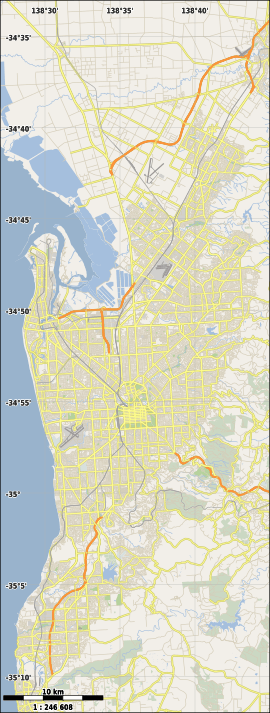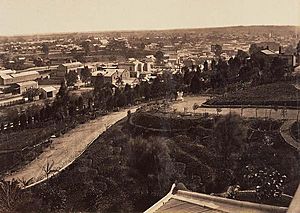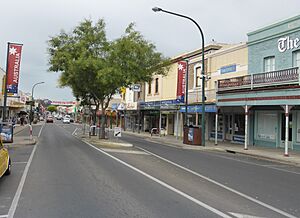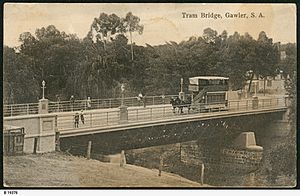Gawler facts for kids
Quick facts for kids GawlerSouth Australia |
|||||||||||||||
|---|---|---|---|---|---|---|---|---|---|---|---|---|---|---|---|
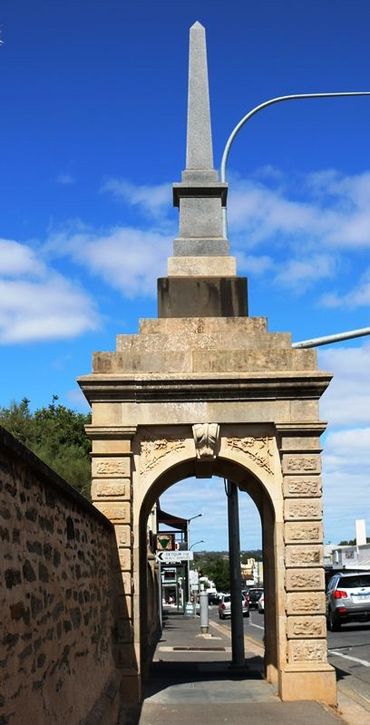
McKinlay Monument, Gawler, South Australia
|
|||||||||||||||
| Established | 1839 | ||||||||||||||
| Postcode(s) | 5118 | ||||||||||||||
| Elevation | 75 m (246 ft) | ||||||||||||||
| Location | 40 km (25 mi) N of Adelaide city centre | ||||||||||||||
| LGA(s) | Town of Gawler | ||||||||||||||
| State electorate(s) | Light | ||||||||||||||
| Federal Division(s) | Spence | ||||||||||||||
|
|||||||||||||||
|
|||||||||||||||
| Footnotes | Adjoining localities | ||||||||||||||
Gawler is a historic town in South Australia. It's known as the oldest country town on the Australian mainland. The town was named after George Gawler, who was the second Governor of the South Australian colony.
Gawler is located about 40–44 km (25–27 mi) north of Adelaide, the state capital. It's also very close to the famous Barossa Valley, a major wine-making area. Gawler sits where two rivers, the North Para and South Para rivers, meet to form the Gawler River.
In recent years, Gawler has grown a lot. It's now often seen as an outer suburb of Adelaide, connecting the city to the countryside.
Contents
The History of Gawler
The land where Gawler now stands originally belonged to the Kaurna people, who are the traditional owners of the Adelaide Plains. South Australia was set up as a British colony. Land was sold to settlers to help the colony grow. Gawler was created from a special land purchase of 4,000-acre (1,600 ha) by a group of colonists.
How Gawler Was Planned
The town's design was created by William Light, a colonial surveyor. Gawler is special because it's the only other town Light planned besides Adelaide. While Adelaide has a square grid, Gawler's center is shaped like a triangle. This unique shape was chosen because of the rivers and hills around it. Light also included parklands along the rivers and public squares, showing he cared about green spaces.
Early Growth and Industries
Gawler quickly became important when copper was discovered nearby in Kapunda and Burra. This made Gawler a busy stop for people traveling to and from Adelaide.
Later, Gawler developed its own industries. There were flour mills, and engineering companies like James Martin & Co and May Brothers & Co. These companies made farming equipment, mining machinery, and even steam trains.
Gawler's Cultural Side
Gawler was once nicknamed "The colonial Athens" because it became a center for culture. In 1859, Gawler held a competition to create an anthem for Australia. This was many years before Australia became a nation. The winning song was "Song Of Australia", written by Caroline Carleton with music by Carl Linger. This song was even considered as a possible national anthem much later.
Gawler also had a horse-drawn tram service. It ran from 1879 until 1931, helping people and goods move around town.
Deadman's Pass Story
There's an old story about a place in Gawler called Deadman's Pass. Before Gawler was surveyed, a group of explorers found a deceased man buried upright near the Gawler River. The story says the man was traveling and collapsed from hunger and thirst. The explorers tried to help him, but he passed away. They buried him in a tree and covered him with clay to protect his body. They called the tree "dead man's tree." This spot, Deadman's Pass, is at the southern end of Murray Street near the river.
Culture and Events
Gawler is a busy commercial hub for the Mid-North region of South Australia.
Sporting Events
Gawler often hosts parts of the annual Tour Down Under, a famous cycling race.
The town also has a big annual event called the Gawler Show. It started in 1856 and is the largest country show in South Australia. Around 30,000 people visit the show each year. The Gawler Show has won awards for being a great community event.
A special charity cricket match, the Hope Cup, is played each year. The Gawler Police team plays against a Salvation Army All-Stars team made up of local leaders. This match raises money to help homeless people in the community. The Hope Cup has also won community event awards. Famous cricketers like Darren Lehmann and Travis Head have supported this event.
Getting Around Gawler
Gawler is a key transport hub. Main North Road connects Gawler to Adelaide city centre. North of Gawler, it becomes the Horrocks Highway. The Sturt Highway goes northeast from Gawler towards the Riverland and Sydney. The Barossa Valley Way leads into the Barossa Valley. The Thiele Highway goes north to towns like Kapunda.
The Northern Expressway is a newer highway that helps traffic bypass Gawler. It's part of a bigger road project that will connect areas south of Adelaide all the way to Nuriootpa.
Train Services
Gawler railway station was the end of the railway line from Adelaide starting in 1857. The line was later extended to other towns. Gawler became a junction, meaning trains could go in different directions. Today, Gawler Central railway station is the end of the metropolitan train services from Adelaide.
Gawler also had a horse-drawn tram service that started in 1879. It carried both people and goods from the railway station along Murray Street. It was very useful for delivering heavy equipment from the local factories. The tram service stopped in 1931 and was replaced by buses.
Famous People from Gawler
Many notable people have connections to Gawler:
- Simon Birmingham, a politician.
- Jack Bobridge, an Olympic cycling silver medallist.
- Peter Brinkworth, who invented chicken salt.
- Wes Carr, winner of Australian Idol in 2008.
- Travis Head, a well-known Australian cricketer.
- Darren Lehmann, another famous Australian cricketer, was born in Gawler.
- Riley McGree, a football (soccer) player for the Socceroos.
- Lisa Ondieki, an Olympic silver medallist in marathon running.
- Sonny Morey, a football player who is in the SA Hall of Fame.
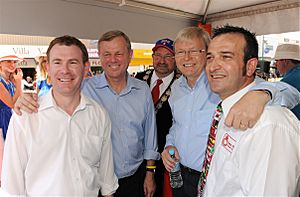
Images for kids
-
Federal MP for Wakefield Nick Champion, Premier Mike Rann, Prime Minister Kevin Rudd and state MP for Light Tony Piccolo in Gawler for the Tour Down Under in 2010


